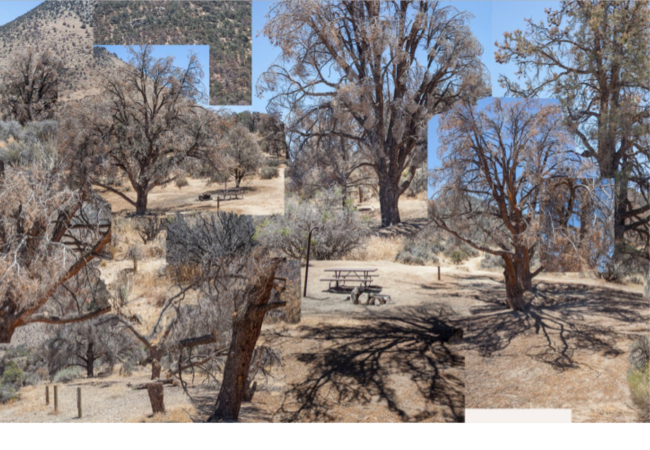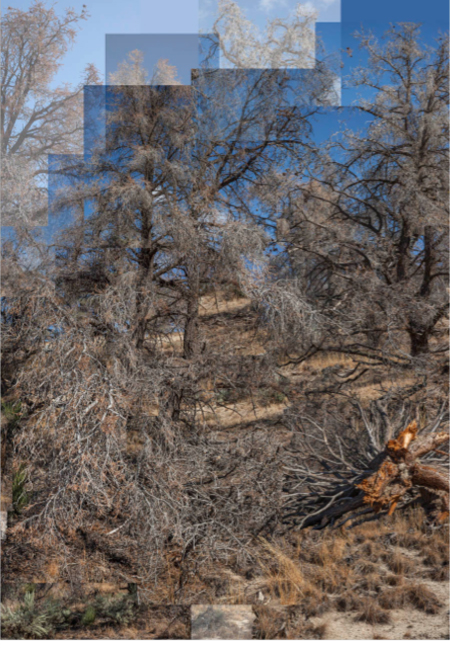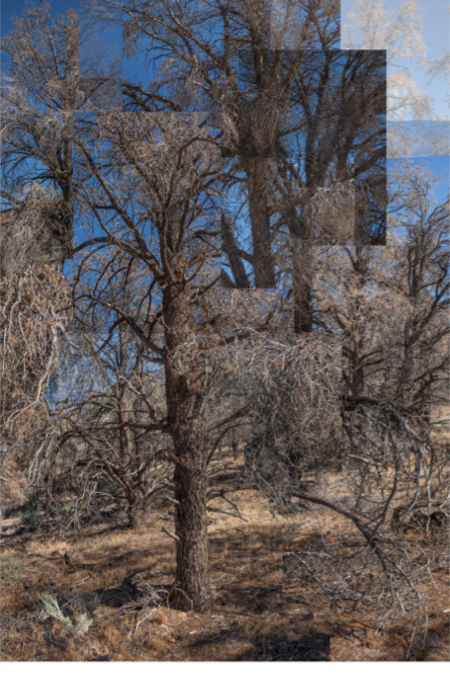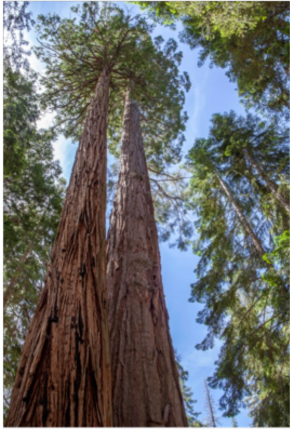“Walking with Trees”
Issue #9, October 2019
TABLE OF CONTENTS
Lise Weil, Kristin Flyntz
EDITORIAL
Carolyn Brigit Flynn
Across the Watershed
Karen Malpede
So Close to Joy If Only…
Juliana Borrero
Landscapes at the End of the World
Rev Dele
Healing Extinction Illness
Ruth Wallen
Walking with Trees
Wendy Gorshinsky-Lambo
What the Worms Say
Anne Dellenbaugh
Only Time to Love
Margo Berdeshevsky
Stand
When Change Hurts the Soul
The Land of Afterwards
Kristinha M. Anding
All We Have Left Unsaid
Sandy Ibrahim
The Descent of Inanna’s Descendants
Marilyn DuHamel
Chama River Revelations
Andrea Mathieson, Cynthia Ross, Debby Black, Nancy Windheart, Anne Bergeron, Lise Weil
Lac Café Medley
Lise Weil
After•Word Trebbe Johson’s Radical Joy in Hard Times
Ruth Wallen
Walking with Trees
This past July I arrived at Walker Pass Campground to begin a four-day pilgrimage to walk with dying trees. I’d been coming here for three years, drawn by a dark red spot on a Forest Service map of tree mortality in California. The Pacific Crest Trail passes through this campground, which I imagine once offered a welcome respite, with tables and fire rings shaded by pinyon pines and juniper. But I arrived in 2016 to brittle needles and rusty brown foliage. A year later, the dying trees deemed hazardous; all that remained were stumps, save one lone tall green pinyon pine that had managed to survive. Grey phantoms stared down from the slopes above the campground.
 Walker Pass Campground 2016, permanent pigment digital print, 53” X 32” (created 2018)
Walker Pass Campground 2016, permanent pigment digital print, 53” X 32” (created 2018)
Now, two years later, even more trees had died. Last winter was a welcome wet one, so even in the hot summer sun, the sage was a lush blue green and the buckwheat bloomed luxuriantly, covered with clusters of tiny white flowers. As I climbed the mountain, I walked past lupines, some still with purple blooms, and was startled by a couple of flannelbushes, blazing with small green tripartite leaves and bright yellow flowers. But most of the trees were shrouded with tangles of bleached white branches, thin twisted claws that hung from each limb. The dry, brittle foliage had long since dropped to the ground. I walked for well over a mile, past one parched skeleton after another. A few had toppled over. As I trudged on to a well-shaded wash, there were hints of green. For a brief moment, I enjoying walking through a shaded grove of living trees, experiencing the forest as it had been only recently. Then the trail opened to grassland, a spot where many trees had fallen. Those still standing were stripped of all but their largest branches--the result, I presumed, of a small fire. The hillside provided a glimpse of what this whole area may look like in coming years, even if the area doesn’t burn again.
I knew that the past year’s rainfall, although it ended the drought for the moment, would not bring back the trees. Six years of drought, the bark beetles that followed and the rising temperatures had all done their work. The trees were dead. It was not with any particular hope that I returned, but simply to be present. The trees called to me. Look. Listen. Walk among us. Be attentive to feeling. Let tears flow. Record what you see. Bear witness.
 Walker Pass 2017, permanent pigment print, 40” X 56”
Walker Pass 2017, permanent pigment print, 40” X 56”
For the past decade, I’ve been walking with trees, starting near my home in San Diego and gradually extending my range throughout the county and northward. Initially I thought that I would be exploring the potential impacts of future changes in climate, but I realized quickly that the combined impacts of urbanization, globalization, in the form of introduced species, and climate change were already wreaking havoc. Until the conflagrations of the last two years, the Cedar Fire, only one of a group of fires that scorched the county in 2003, was the biggest fire in the state. That fire was followed by another in 2007. Together they killed well over half of the conifers in the county. The Goldspotted oak-borer, likely introduced from Arizona, was devastating the coastal live oaks and deciduous black oaks. Urbanization continued to gobble chaparral, as massive subdivisions the size of whole towns were constructed one after the other.
What I saw in San Diego was a precursor to what would happen throughout the state. Drought hit California in 2011, killing over a hundred million trees by 2016, followed by half again as much by the time of this writing. A hundred million trees! A hundred and fifty million trees! For years I scoured the internet for information, but news coverage was always scarce. So I looked for the closest places on the Forest Service maps of dying trees, which often didn’t extend southward all the way to San Diego, and headed north, arriving first at Walker Pass, then continuing west to the southwestern tip of the Sierras. On my first visit to the Sierras it looked like fall colors, except that I was in California in July, not Vermont in October. The green mountainsides were dotted with cones of orange. Something was very wrong. Where was the public outcry? Was anyone paying attention? Did anyone care?
I walked and I photographed. I would come to trees that called me and photograph them repeatedly, close-up, from many angles and varying perspectives, as I looked intently. Later I would assemble some of these photographs into montages, montages comprised of a series of glances. A meager attempt to convey the dynamic feeling of walking in the forest—but a way for me to express respect and love for what I experienced in this living and dying place.
 Walker Pass 2017, permanent pigment print, 38” X 56”
Walker Pass 2017, permanent pigment print, 38” X 56”
This summer, for the first time, I passed a hiker on the trail. From a distance, I saw another car briefly pulling into the campground. In other ways, I felt less alone as well. The series of blazes in California over the past two years had raised some awareness of fire danger and drought. It seemed like discussion of climate change and the extinction crisis were finally more frequently in the news. The extinction rebellion was beginning to make noise. A green new deal was a topic of discussion.
A look at the data from the Yale Program on Climate Change Communication, which charts public opinion about climate change in the US, does show a 13% rise, from 2015 to 2017, to 44%, in the number of people who think that they will be personally affected by climate change, but since 2017 that figure has remained static. Disturbingly, it took until 2017 for a greater number of people to believe that global warming was mostly human-caused than held that belief a decade earlier. After that number rose further in 2018, to only 62%, it dropped in the most recent poll.i
On the other hand, a 2018 survey found that while the percentage of those worried about global warming was rising, the sense of hope was diminishing. In 2017 while less than 60% thought climate change was human-caused, almost 40% thought the odds of humans going extinct were at least 50%. As a society, are we moving from denial to despair, from one form of immobility to another? Certainly, in the past year I have had more students suffering from depression and more anguished discussions than ever before.ii
Having overlooked emails, I came to Deena Metzger’s essay only very recently. The truth of her words is still permeating my being; I write this essay in an effort to untangle their meaning. Metzger’s voice is one of a growing chorus. For months, I’ve been contemplating Jem Bendell’s paper, “Deep Adaptation: A Map for Navigating Climate Tragedy.” He begins his article questioning “the assumption or hope that we can slow down climate change, or respond to it sufficiently to sustain our civilization.” Writing for an academic audience, Bendell systematically assesses climate data and current trends, drawing the conclusion that the collapse of existing social and economic systems is not just a possibility but likely.iii
Metzger is even more direct. “We are all going extinct…We are all going extinct.” I pause in recognition. Is that what the trees are trying to tell me? Is that why I come back to Walker Pass year after year, hiking further each time, slowly learning to take in this reality, to let it fully penetrate?
I am grateful for the truth of Metzger’s words, even as I resist them. I ponder her claim that we all know the illness of which she speaks. Then I float back to my ten-year old self reading On the Beach, desperate about what to do when the radiation came, looking at a map for places further south than Melbourne, Australia, where the radiation cloud was heading. The prospect of extinction has been with most of us for our entire lifetime. An expanding cloud—as the possibilities of which plot might drive the story continue to multiply.
Even more than radiation, as a child, I was haunted by the stories of my relatives. I imagined living for years in the crawl space under our house. I developed elaborate strategies for where I would’ve hidden or might hide when the Nazis came.
Walking among these trees, slowly I come to accept that there is nowhere to hide. It is not about what happens to me. It is not about individual survival. No one can survive alone. I am fortunate to be with these trees. Even the barren branches offer some shade and comfort. I will listen. I will ask for guidance. How can I serve them? I will love, and appreciate the love they give back.
The forest at Walker Pass was and still is a place of beauty. I am so grateful to be here. Even as this charnel ground reveals the illness in stark terms, it is alive. Woodpeckers knock on trunks of dead trees. Death is converted into new life. Grasslands will likely replace trees, but they too provide shelter and food for animals.
Invoking indigenous knowledge, Martin Prechtel writes eloquently about the power of praise.
I come across a pinyon pine bulging with hundreds of small green cones. My amazement brings tears; there are miracles in this forest. I recognize the truth of Prechtel’s words, how grief and praise, the subtitle of his book, are intertwined. The more we can praise, declare gratitude, the more we can open our hearts till bursting with compassion as we take in the heartbreak of the world.
A few more steps and a large black beetle moves across the path. It is not only praise but wonder that fills my being. In these bleak times, moments of enchantment are more important than ever. Biologist Brian Goodwin argues that the disdain, or even fear, of animism that has permeated the modern scientific perspective is no longer logically consistent. As he puts it, in nature you don’t get “something from nothing.”v In order for consciousness, for sentience, to arise, there needs to be an antecedent that is also sentient. Sentience can’t arise from dead world. What a gift to be alive in this vibrant pulsating world.
*****
Someday I will come to Walker Pass with a group of women. Together we will learn from this place. Alone, it is not safe to spend the night in a desolate, deserted campground, so I drive on to the western side of the Sierras. The next morning, I marvel at the sounds of birds and the smell of greenery. Emerald green lit by rising sun. I walk around the campground bathing in astonishment. Then through a gap in the trees I see the mountainside beyond, lined with one grey trunk after another. An occasional tree is covered in orange needles, but mostly I see clusters of grey spires, mixed with some cones of green.
I’d driven slightly further north than the isolated southernmost finger of the Sierras, Alta Sierra, that I’d visited in the past. What a surprise to wander across the street to the Long Meadow Grove and follow the Trail of 100 Giants! In mid-elevation moist pockets along the western slope, nested among the pine, cedar and fir, grows Sequoiadendron giganteum. The giant sequoias are said to be the most massive trees on earth. In contrast to the rest of my journey, the trail is carefully laid out for the numerous visitors I encounter along the path. I stop at an enormous tree trunk. In this grove, the largest has a diameter of twenty feet. The larger redwoods are over 1500 years old. Their dense foliage is packed at the top of immense bare trunks that tower above the pines and fir. However, looking down at my feet, the ground is strewn with logs and stumps. Logging has been prohibited since this grove was designated part of the new Sequoia National Monument in 2000. Nonetheless, the sea of logs is endless. Here again, countless dead pines, cedar and fir have been cut down to safeguard visitors from falling trees.
Fortunately, these redwoods aren’t canaries. A ranger told me that there was almost no redwood mortality from the drought, their roots highly efficient at capturing what water is available. Redwood trees do need a lot of water. Bearing witness for millennia, they grow near streams that are fed by springs or gather the water running down from the mountainsides. As the elders and giants of the forest, what stories do they have to tell?
The native peoples called the redwoods by various names, including wawona, toos-pung-ish and hea-mi-withic. A look at tree rings and scorch marks would indicate that their home was regularly burned by the native peoples, including the Tubatulabal and Yukots, until the 1850s. These fires were vital to the survival of redwoods, releasing seeds from their cones, clearing away brush, exposing the soil, recycling nutrients and creating holes in the forest canopy so that sunlight could reach young seedlings. For indigenous peoples, the fires encouraged the growth of edible plants and fungi and created better habitat for deer and elk. These cycles of mutual benefit came to an abrupt end in the decade of the 1850s as settlers and loggers flocked to the region, bringing wars, disease and decimation. The rapid decline of native populations throughout California was astounding–at least 80 percent from 1846 to1873! Those who had frequented this grove for millennia and managed to survive the massacres were moved to a farm in 1856, then, combined with other survivors, to a reservation, and then to another, fully established in 1873, further away from the rich farmland coveted by the settlers.
The redwoods were corralled in differing ways. Word of the “discovery” of these giants quickly spread among the settlers in 1852 and reached Europe by the following year, after which time others vied for the honor, claiming earlier encounters. Loggers flocked to this newfound bonanza, cutting down, with great effort, the first tree in 1853, only to find that its wood was brittle, fibrous, with low tensile strength, shattering tremendously when felled. Soon after this first tree was logged, a 120-foot scaffold was erected and the bark was stripped off another tree to be shipped off to England and reconstructed, while the tree was left to die. Massive trunks of other redwoods became popular items of display, shipped off to the Philadelphia Centennial Exhibition of 1876, the 1893 World Columbian Exposition in Chicago, the Mall in Washington DC and more. Despite their limited commercial value, logging of giant sequoia continued until the 1920s, and logging of their old growth coastal cousins continues to this day.
Giant sequoias regularly live for over 3,000 years. The oldest living tree is over 3,500 years old, beginning its life before the beginning of the writing of the old testament. It has been less than two hundred years since the first known observation of these trees by Europeans in 1833.
 Trail of 1000 Giants, 2019
Trail of 1000 Giants, 2019
Peering up at these tall sentinels I reflect on the efforts of the early settlers to describe the gigantic dimensions of what they saw. No calipers were big enough to measure their diameter. Triangulation of their height was a rough approximation at best.
What if the height of these trees, instead of being quantified, is perceived as an invitation to imagination, to spaciousness, to an extended sense of history? Immediately visible from their perspective might be the precarity of their existence, and the impossibility of “saving” one species alone. Diminishing winter snowpack and rising summer temperatures affect all of the trees and may create moisture deficits the redwoods can’t survive.
If soaring height isn’t enough to inspire a broad perspective, consider all that is unseen, spreading outwards in the depths of the soil. Much of the redwood tree lives below the surface. Their root systems are relatively shallow, but those of a single tree can extend as far as an acre. Like most trees, their roots are entangled with mycorrhizal fungi, forming a vast network that allows them to communicate with each other, to share nutrients, warnings of pests, and perhaps even to hear the sound of water. Learning about the multitude of functions of mycorrhiza is part of a reorientation of scientific thinking to focus on symbiosis, as opposed to competition, as a driver of evolution and change.
There is so much to learn from the forest. The forest can inspire, or restore, not only ways of thinking but ways of acting. The interpretive panel beside the enormous trunk of a tree that toppled in 2011 reminds the reader that life and death are intertwined. As they gradually decompose, logs provide habitats for so many creatures, from fungi, plants, salamanders to small mammals. Mimicking this natural process, the permaculture practice of hugelkultur covers fallen logs with twigs, leaves and soil, planting on top, the logs holding moisture and gradually releasing nutrients to fertilize the growing plants. Two years ago, fellow artist Nina Karavasiles and I used this technique to create a memorial to dying trees. We placed logs in the shape of a fallen tree and planted a pollinator garden on their mounded forms. The first summer plants attracted butterflies, hummingbirds and even a monarch caterpillar. While a few of the native plants didn’t survive the dry summer, the seeds we scattered covered the logs with poppies the next spring.
 “Pushing Up Daisies,” at California Center for the Arts,
“Pushing Up Daisies,” at California Center for the Arts,
Nina Karavasiles and Ruth Wallen July 2018
Metzger’s comment about the imperative to “restore and co-exist in different degrees with the wild everywhere” touches me deeply. So much can be said about how we can bring the wild into our cities—planting trees, greening roofs, creating community gardens and cherishing the wild spaces that still exist. I love to roam in the canyons that run throughout San Diego, many of which are relatively intact. Systems of creeks and rivers serve as lungs and circulatory systems for any city and as such need to be nurtured and protected.
The agricultural practices that pushed the native peoples off their lands could also be completely reshaped to work with the wild instead of struggling against life processes. Water harvesting, collecting water where it falls and preventing the erosion that accompanies run-off, is particularly important in drier areas. Regenerative agriculture has the potential not only to enhance soil fertility and eliminate the use of manufactured pesticides and fertilizers, but to capture some of the carbon that humanity has emitted into the atmosphere and sequester it in the soil. By not tilling the soil, planting a variety of trees and crops that provide continuous cover and nutrients, including nitrogen fixers, and then mowing these crops repeatedly, it is possible to store carbon in the soil while increasing soil fertility. Intercropping with trees, creating hedgerows, or planting crops of multiple heights (multi-strata agriculture) are additional possibilities that increase regenerative potential. All of these practices could be adopted in the San Joaquin Valley, the fruit and vegetable basket of the US, which lies just west of the redwoods at Long Meadow Grove.
On the last day of my forest pilgrimage I hiked for miles up a ridge in the hot sun, seeing no one. Much of the time I walked among black oaks and chaparral, and through occasional clearings could peer across to the steep slopes of the opposite ridge. Rounded clumps of bright green oaks were mixed with the darker green, or too often grey, conical shapes of taller conifers. I was seeing the type conversion that ecologists have predicted—as the climate warms, conifers will move upslope and oaks become more prevalent at lower elevations, until, I fear, either the Goldspotted oak-borers from the south, or sudden oak death from the north, reach this area. Black oak is susceptible to both.
No one knows precisely where the process of ecological change is leading or how fast changes will occur. For now, it is evident that trees are dying, trees that hold tremendous knowledge both in their lives and as they perish. It is vital to learn to be with all of the emotions that come with this knowledge, to support others to do likewise, to speak about what we perceive—constantly—and to work together, as Metzger prescribes, “to willingly, ruthlessly and essentially change our lives.”
ABOUT THE AUTHOR
Ruth Wallen is a multi-media artist and writer whose work is dedicated to encouraging dialogue about ecological and social justice. After initial work in environmental science she turned to art to pose questions beyond disciplinary boundaries, address values informing environmental policy, and contribute to the development of the field of ecological art. She creates interactive installations, outdoor nature walks, web sites, artist books, performative lectures and more. A recent work, Listen to the Trees, uses tree rings to visualize scientific models of future climate. She teaches for the MFAIA in Interdisciplinary Arts program at Goddard College and is a lecturer at UCSD. Her website is: www.ruthwallen.net Instragram:@listentotrees
To comment on this article, please click here.
Copyright © 2014-2021 Dark Matter: Women Witnessing - All rights reserved to individual authors and artists.
Email: Editor@DarkMatterWomenWitnessing.com
Please report any problems with this site to webmaven@DarkMatterWomenWitnessing.com
